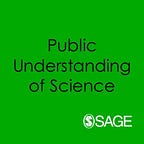Telling Science Stories — reporting, crafting and editing for journalists and scientists
Review by Holger Wormer
This book is a good addition to the existing literature on working aids and techniques for telling stories, for designing lectures and many very interesting suggestions for further teaching resources. But it is not the big, catchy and yet critically questioning story about telling stories in science.
“Everybody loves stories.” “You can’t beat story.” “Story adds meaning.” These are just three sentences taken from the almost indoctrinating introduction of this book underlining that the author has “one goal and one goal only: to bring together the seemingly contrasting worlds of science and story”. There may well be a question as to whether we can completely agree with this goal but what could be more appropriate than to look at this work by its own standards?
At first glance, the book seems to fulfil at least some demands for a good story. For example, it “follows a protagonist” (mostly the author himself), “with a clear goal” (see above), “facing obstacles” (the treatment of a complex issue) which should be overcome with the proven means of how-to-manuals: each chapter has a standardised formal structure, starting with “What-you-will-learn”-bullet-points, followed by a (rather long) summary of the chapter and ending with review questions, links and references.
After the extensive introductory plea for storytelling in science, the following chapters cover a wide arc of topics from finding science stories (including an excursion into news theory), a treatment of “narrative structure” and “story formulas”, up to aspects of language and editing, literary techniques and screen-writing. Common aspects of narrative research are explained: the three-act structure from Aristotle or the American screenwriter Syd Fields, Gustav Freytag’s five-part pyramid model and, of course, the heroic journey according to Joseph Campbell and its adaption by Christopher Vogler.
These are treated in a somewhat scattered manner in different chapters, not always meaningfully connected, neither between each other nor with their practical application to science stories. When this is consistently attempted, for example, through a paragraph-by-paragraph analysis of a popular science press article, the book shows its potential strength. But between such highlights one gets lost sometimes in numerous strands of action, which are taken up again at various points, without a clear red thread always being recognisable.
Space to link more effectively the different narrative threads could have been easily created: some sub-chapters come out of the blue, dealing with negligible side-aspects of storytelling (such as tips on interviewing). These can be found in other specialist books and do not necessarily belong here. Many lengthy passages and repetitions could also have been avoided. For example, it is not that difficult to understand that a story usually involves a protagonist, a goal and a journey with obstacles. Or, to put it in the author’s style: “Come on, we got it. Not necessary to repeat. Not a dozen times”.
A plus point, on the other hand, is the discussion of the potential abuse of storytelling techniques in fake news stories but also in scientific publications. It is important to consider how much storytelling can be justified to construct a good ‘research story’. At what point might this distort scientific results by establishing causalities that are not proven? Such ethical considerations could even have been extended, taking in statements from the literature such as Katz’s article, ‘Against storytelling of scientific results’ or the findings of Sumner and colleagues (British Medical Journal, 2014) that over-telling of results can often already be found in scientific publications.
Instead, despite some slight cautions, the author remains true to his goal when he concludes that “storytelling beyond current dissemination practice is a must”. Perhaps it is also due to the zeitgeist with its current saturation of stories from everywhere that this absoluteness seems somewhat out of time even to a science journalism teacher. A book like this one should probably differentiate much more in which cases short, striking facts can be considered the more credible way of communicating science, when a six-word story is worthwhile, and when a comprehensive story is really appropriate.
If, however, there is really no alternative to storytelling, one wonders why this oeuvre as a whole is so far from packing its core messages into a coherent story. The author even admits that “this book … doesn’t have a narrative structure”. The result is a not-always-sorted collection of working aids and techniques for telling stories, for designing lectures and many very interesting suggestions for further teaching resources. In this respect, the book is a good addition to the existing literature on the subject. But it is not the big, catchy and yet critically questioning story about telling stories in science.
Holger Wormer holds the only full professorship for science journalism at a German university (TU Dortmund). His research deals with quality and ethics in science communication. Recent publications include ‘German Media and Coronavirus’ and ‘Teaching science journalism as a blueprint for future journalism education’
